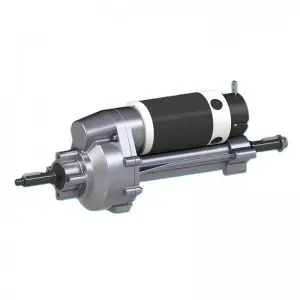The transaxle is an important part of a vehicle’s drivetrain, responsible for transmitting power from the engine to the wheels. They are commonly found on front-wheel drive and some all-wheel drive vehicles and play a vital role in a vehicle’s overall performance and functionality. An important aspect of the transaxle system is the shifter, which allows the driver to control gears and engage the transmission. In this article, we’ll discuss the process of connecting a shifter to the transaxle, providing a step-by-step guide for those who wish to understand and perform this task.
Before delving into the details of connecting the shifter to the transaxle, it’s important to have a basic understanding of the components involved. The transaxle combines the functions of the transmission, axle and differential into an integrated unit. It is usually located between the front wheels and connected to the engine via the driveshaft. A shifter, on the other hand, is the mechanism that allows the driver to select different gears and control the transmission. It is usually located inside the vehicle and connected to the transaxle via a series of connecting rods or cables.
The process of connecting the shifter to the transaxle may vary depending on your specific vehicle and transmission setup. However, the following general steps can serve as a guide for this task:
Identify the shifter and transaxle configuration:
Before beginning the installation process, it is important to determine the type of shifter and transaxle configuration you have in your vehicle. This will help determine the specific requirements and steps involved in connecting the shifter to the transaxle. Some vehicles may have a mechanical connection between the gear lever and the transaxle, while others may use cables or electronic controls.
Gather necessary tools and materials:
After determining your shifter and transaxle configuration, gather the tools and materials needed for installation. This may include wrenches, sockets, screwdrivers, and any specific components or hardware needed to connect the shifter to the transaxle.
Inspect the shifter and transaxle assembly:
In order to connect the shifter to the transaxle, you need access to components of both systems. This may involve removing the center console or interior trim to gain access to the transmission mechanism, as well as accessing the transaxle links or cables underneath the vehicle.
Connect the shift lever to the transaxle:
Depending on your configuration, you’ll need to connect the shifter to the transaxle using the appropriate linkage, cables, or electronic controls. This may involve adjusting the length or position of the linkage to ensure proper alignment and operation.
Test gear lever operation:
Once the shifter is connected to the transaxle, it is important to test its operation to ensure it engages the transmission properly and allows smooth gear selection. This may involve starting the vehicle and cycling through the gears while checking for any sticking or difficulty shifting.
Adjust and fine-tune as needed:
After testing the shifter operation, make any necessary adjustments or fine-tuning to ensure optimal performance. This may involve adjusting the linkage length, tightening any fasteners, or calibrating the electronic controls to achieve the desired shift feel and responsiveness.
Reassemble and secure components:
After the shifter is properly attached to the transaxle and tested for operation, reassemble all removed internal components and secure all fasteners to ensure a secure and secure installation.
It’s worth noting that the process of connecting the shifter to the transaxle may require a certain level of mechanical knowledge and experience. If you are uncomfortable performing this task yourself, it is recommended that you seek the help of a qualified automotive technician or professional.
In summary, connecting the shifter to the transaxle is a critical step in ensuring proper functioning of your vehicle’s driveline. By following the steps outlined in this article and understanding your vehicle’s specific configuration, you can successfully connect the shifter to the transaxle and enjoy smooth, precise gear selection while driving. When working with any auto part, always prioritize safety and precision, and seek professional help when needed.
Post time: Apr-08-2024


